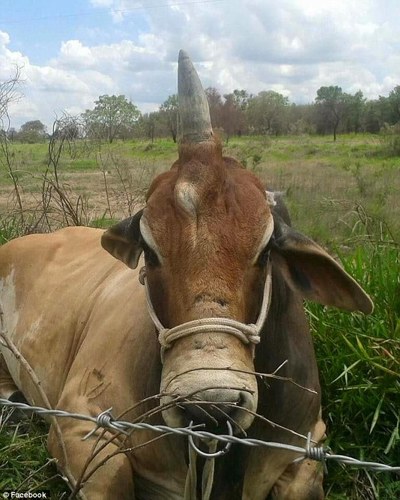
Could we genetically engineer a unicorn?
May 10, 2024

- Related Topics:
- Genetic engineering,
- Animal biology,
- Quirky questions,
- Developmental biology,
- Editor's choice
A high school student from the UK asks:
"I was wondering if there is a possibility that, due to the newest breakthroughs of genetic engineering, if you separated the dna strand for a narwhals tooth/horn and infuse that into a horse embryo, could you theoretically make a unicorn?"
Although unicorns only exist in fantasy, we may eventually be able to bring them to life with genetic engineering. We don’t currently have all the tools or scientific knowledge to do this, but let’s talk about some ways we could imagine this happening in the future!
Putting new genes into animals
Every living thing contains genes, which act as a sort of instruction manual for building an organism and keeping it alive. While it might sound like science fiction, we are able to take genes from one organism and insert them into a different organism. This process of transgenesis has actually been possible since the 1970s!
Some transgenic animals aren’t too hard to make these days. For example, you can buy your very own glow-in-the-dark fish called a Glofish! Glofish are made by taking a fish and inserting a gene originally from a jellyfish. The fish use this gene as instructions for a protein that makes them glow bright colors!

So, could we insert a ‘horn gene’ into a horse to make a unicorn?
Unfortunately, it’s not that simple. You can create Glofish by giving them a single gene. But it takes a lot of genes working together to grow a horn. So how do we figure out what genes we need?
To answer this, we can look at some horned animals as a starting point. Let’s consider a few candidate animals!
Meet the candidates
First up we have the narwhal. It has a spiral tusk, which may even be the inspiration for the European unicorn legend. But unfortunately, while it may look like a unicorn horn, it’s actually a very unusual tooth. Narwhals are difficult to study, so we don’t know much about the genes that make these tusks.
There’s also no guarantee that putting ‘tusk genes’ in a horse would grow a horse tusk. Narwhals and horses are not closely related, so tusk genes might cause unintended or no effects in a horse.
Even if it did work, it would look a little silly to have a horse with a really long tooth! So let’s consider some other animals.
Next up we have the rhinoceros. They too have been linked to unicorn legends, and the scientific name for the Indian rhino is even Rhinoceros unicornis! Rhinos might be the closest animal we have to a unicorn. Unfortunately, like the narwhal, we don’t know much about how rhino horns grow. So we might be better off starting with an animal that has been studied more in depth.
Let’s next consider the horns of hooved animals like goats and cows. While these horns might look different from a unicorn horn, we have a better idea of how they grow.

How do horns grow?
Most of our knowledge of how horns grow comes from researching livestock, like cows and goats. While their horns might look simple, it involves a lot of moving parts to make them!
Horns grow from structures called horn buds, which form while the animal is still developing inside its mother’s womb. After birth, the horn bud starts making keratin, the same material your fingernails are made of. Simultaneously, bone begins to grow underneath. It takes a lot of genes to coordinate these processes — scientists have identified 58 genes that ‘turn on’ in the horn bud1.
So do we need to insert all of these genes into a horse to get a horn to form? Not quite. The horse has its own version of most of these genes already. In fact, us humans have these genes too! These genes play a role in many other biological processes, and we could not live without them. The bigger question is what causes these genes to turn on in the horn bud.
Part of the answer might be found in cows that don’t grow horns. When scientists examined horned vs non-horned cattle, they didn't find any differences in those 58 horn genes. But they did notice that all the hornless cattle had mutations in one specific region of their DNA. These mutations prevented the horn-forming genes from turning on in the horn bud2. Without activating these genes, a horn doesn’t form.
So are these mutations all affecting some ‘master gene’ that coordinates the entire horn-forming process? Surprisingly, these mutations don’t actually change any genes, but instead change some DNA in between genes. This altered DNA affects how surrounding genes turn on, although we don’t fully understand how this works yet.
So if we want to get a unicorn, we would first need to find the DNA responsible for turning on the horn-forming genes and insert it into a horse. This also might require tinkering with the other horn-forming genes to make sure they respond to the transgenic DNA. But without in-depth knowledge of horn formation, we are still far off from making this happen.
We want a unicorn not a horned horse!
No one really asked for a horse with two horns — we want the classic unicorn with a single, majestic horn sticking out of its forehead. How can we get a single horn to form exactly on the horse’s forehead?
Animals often coordinate where certain body parts form through something called enhancers. Enhancers are different from genes. They don’t make proteins, but they turn on certain genes. Some enhancers only activate in specific parts of the body. For example, enhancers that activate in our hands turn on genes that are involved in finger formation. The piece of DNA that turns on the 58 horn-forming genes in the horn bud might be an enhancer3.
So, it’s possible that we find enhancers that activate on the horse’s forehead. We can do this through something called an enhancer trap, where we genetically modify an organism to show us where certain enhancers are active as it grows. If we were to find a ‘forehead enhancer,’ we might be able to make it activate horn-bud related genes and get a unicorn horn. Unfortunately, this experiment would take extremely long since horses grow so slowly.
Another way we could get a unicorn horn is through studying rare mutants. A very small handful of cows and goats have been reported before to grow only one horn. If we can understand why these animals only form a single horn bud, we can possibly use this knowledge to grow a single horn in a horse.

Bringing the unicorn to life
So, what would it actually take to make a unicorn? Well first, there are a few big gaps in knowledge that we would need to address:
- What DNA is responsible for starting the growth of a horn bud?
- Can we get this DNA to create horns in horses? Or are more things required?
- How can we create a single horn bud in the forehead and not two on the sides?
Assuming we answer these questions, it might one day be possible to insert DNA into a horse to grow a unicorn horn. Currently, it’s hard to say how feasible this grand idea is with so many unknowns. But as our knowledge of biology advances, unicorns may one day change from a creature of fantasy to your next method of transportation.

Author: Raleigh Slyman
When this answer was published in 2024, Raleigh was a Ph.D. candidate in the Department of Mechanical Engineering, studying human embryo organization in Ovijit Chaudhuri’s laboratory. He wrote this answer while participating in the Stanford at The Tech program.
 Skip Navigation
Skip Navigation
